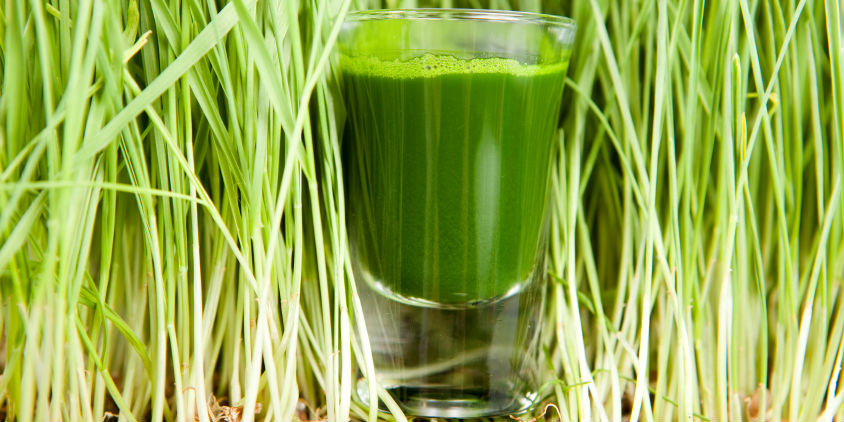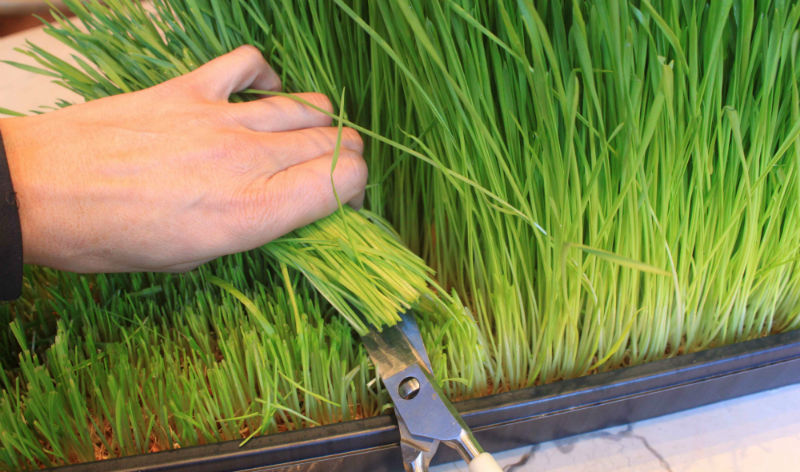Nature’s greatest healer, wheatgrass is abundant in vitamins and minerals, exceptional in its chlorophyll content and a powerful purifier of our internal organs. Best of all, wheatgrass is very cheap and exceptionally easy to grow.
Juicing Wheatgrass
Wheatgrass is grown from the wheat seed (wheat berries), which is the whole kernel of the wheat grain. Wheatgrass blades look very similar to those of any common lawn grass but the similarity ends there. Wheatgrass is considered by many people to be the most healing of all grasses. It is one of nature’s richest sources of vitamins A and C and is rich in calcium, magnesium, phosphorus, iron, potassium, sulfur, sodium, cobalt and zinc. Wheatgrass is also abundant in vitamin B-17, a substance that can destroy cancer cells selectively. Wheatgrass juice is exceptionally high in its chlorophyll content which helps to suppresses bacterial growth in the body and counteracts ingested toxins. It also helps to purify the liver, build the blood’s oxygen-carrying potential and regulate digestion.

Juicing Wheatgrass
Wheatgrass is not easy to drink. Because of its incredibly powerful properties a very small amount on its own can cause nausea and even slight dizziness or light headedness. We recommend starting with a small amount, no more than an ounce and you can gradually increase it, depending on how you feel or if you are juicing it because of a particular ailment.
We have found the easiest way for us to drink wheatgrass is to add it to a fresh juice. You get all the goodness but make it much more palatable. For this reason we recommend the Samson 6 in 1 Juicer. The Samson 6 in 1 was the original wheatgrass Juicer and for performance and value for money is the still the best choice, It does a far superior job of extracting the juice and has the advantage over the manual machines in that you can also juice your fruit and vegetables to then mix with your wheatgrass.
Benefits of Wheatgrass
Some of the benefits of wheatgrass and extracting juice from the blades include the following:
- Lowers blood pressure by cleansing and dilating the body’s blood pathways
- Reduces over-acidity and restores alkalinity to the blood
- Detoxifies the liver and bloodstream
- Recent studies show that wheatgrass juice has a powerful ability to fight tumors without the usual toxicity of drugs that also inhibit cell-destroying agent
- Heals the skin externally and is soothing for burns, scrapes, rashes and bites.
- Works as a sleep aide. Merely place a tray of living wheatgrass near the head of your bed. It will enhance the oxygen in the air and generate healthful negative ions to help you sleep more soundly.
- Is a beauty treatment that slows down the aging process by cleansing the blood and helping to rejuvenate aging cells, tightening loose and sagging skin.
How to Grow Your own Wheatgrass

The following Growing Basics for Wheatgrass from Hippocrates Health Institute:
- Soak your hard winter wheat seed (also called wheat berries) overnight (8 to 12 hours)
- Sprout the seed in a jar for the next 16 to 24 hours, rinsing the seed well three times a day.
- After a very short “tail” is visible, plant the seed on top of the soil. Basic potting mix or topsoil will work fine. Peat moss is an important ingredient to look for in your soil so if you have to add it, the mix is one part peat moss to three parts soil, filled halfway up a two-inch deep tray.
- Water the tray and then cover the seeds to keep them from drying out for the first three days.
- During the first three days of growth, water once a day in the morning and really soak the soil (until the tray drips is a good sign you are watering enough). Then lightly mist your seed in the evening (lift cover off to mist seed).
- On the fourth day, uncover grass (roots should begin to take over your soil), water heavily once a day and keep the grass in the shade (never direct sunlight).
- For mold problems, increase your air circulation with a fan or air conditioning to keep the temperature between 60 and 80 degrees Fahrenheit (21° to 26° Celsius).
- Harvest grass when a second blade of grass appears on the grass blades, or when the grass “splits” toward the bottom of the blade. Average growing time is seven to 12 days, depending on the weather, but still always watch for the second blade of grass as you can never judge by how many days it has been growing or how tall the grass is.
- Only harvest once. Cut grass will store in the fridge for about seven to 10 days or longer in Green Bags. Then start the process all over again with new seeds and soil.
